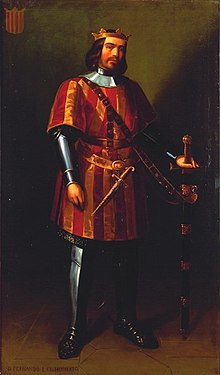Caspe compromise
The Caspe Compromise ( Spanish : Compromiso de Caspe ) was the procedure established by the negotiators of Aragón , Valencia and the Principality of Catalonia to end the interregnum in Aragón, which was created by the death of Martin I of Aragon . As an intermediate stage, it was preceded by the Alcañiz Agreement ( Concordia de Alcañiz ).
initial situation
Martin I of Aragon died on May 31, 1410 without leaving an heir to the throne. He had four children ( Martin , Jaime, Juan and Margarita) who all died before their father.
This situation of unregulated succession, based on the candidates in question, harbored the risk of a war of succession . Due to the real balance of power, two contenders initially had the best chances:
- Jaume II , Count of Urgell , paternal great-nephew of Alfonso IV of Aragon
- Louis of Anjou , Duke of Calabria , maternal nephew of Juan I of Aragón
But there were also other contenders:
- Fernando de Trastámara , Infante of Castile , maternal nephew of Pedro IV of Aragón
- Alfonso de Aragón y Foix , Duke of Gandía , Count of Ribagorza , maternal nephew of Jaume II of Aragón
- Joan I, Count of Prades , as the brother of the aforementioned Alfons I with the same - as a younger, subordinate - dynastic claims
- Fadrique de Aragón, Count of Luna, illegitimate son of Martin I of Sicily
procedure
The negotiators of Aragon, Valencia and the Principality of Catalonia met on February 15, 1412 in Alcañiz to discuss procedural issues. The negotiations were hampered by fights between the aristocratic factions, the impatience of Jaime II's supporters, and the intervention of Castilian troops on Fernando I's side. In the Alcañiz Agreement (Concordia de Alcañiz), the representatives finally agreed on the following nine people who should be in the Aragonese city of Caspe by voting on the rights of the pretenders:
- Domingo Ram, Bishop of Huesca .
- Francisco de Aranda, former advisor to the crown and envoy to the antipope Benedict XIII
- Berenguer de Bardají, scholar and lawyer of the Cortes of Aragón
- Pedro de Sagarriga, Archbishop of Tarragona
- Bernardo de Gualbes, Syndic and Councilor of Barcelona .
- Guillem de Vallseca, General Counsel of the Catalan Cortes
- Bonifacio Ferrer, Prior of the Carthusian Monastery of Porta Coeli
- San Vicente Ferrer , Valencian Dominican
- Pedro Beltrán, Valencian citizen and legal scholar (he replaced Ginés Rabassa)
poll
The vote took place on June 24, 1412. At first the Catalan representatives seemed undecided, while the Aragonese and Valencians were closer to the wool trade in Castile and therefore voted for Fernando von Trastámara. The end result - based on the votes of the three Aragonese representatives, the two ecclesiastical representatives of Valencia and Bernardo de Gualbes as representative of the Catalan bourgeoisie - was in favor of Fernando. On June 28, 1412 he was proclaimed King of Aragon as Fernando I.

